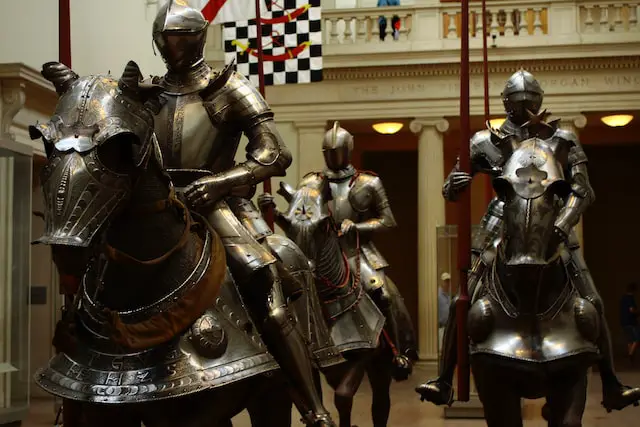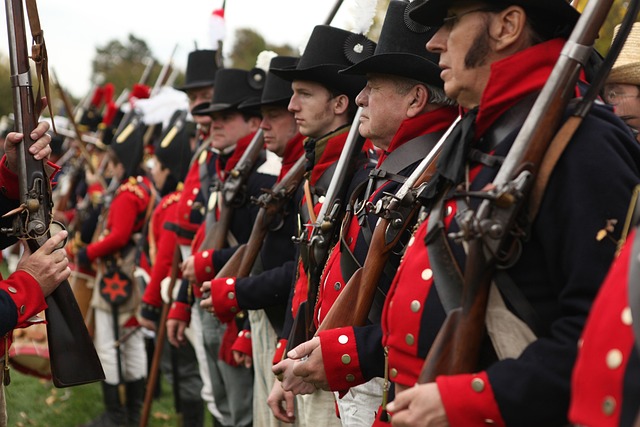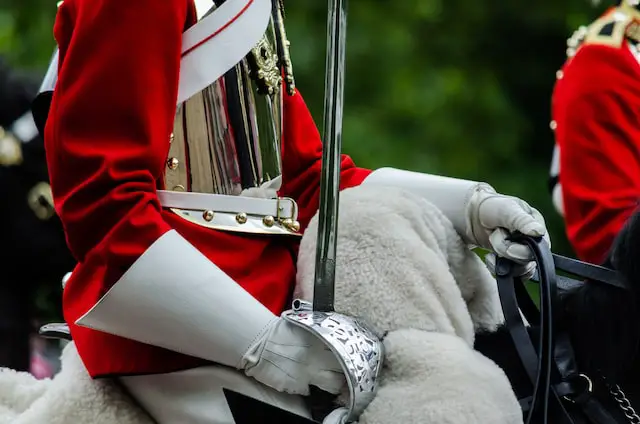Cavalry soldiers were traditionally mounted on horseback, giving them an advantage in speed and mobility over their infantry counterparts who had to march on foot. Infantry units typically carried heavier weapons and armor than cavalry, allowing them to better withstand enemy attacks. Both types of troops have played a vital role in history, from ancient times through to modern day warfare.
What is cavalry?
(Photo by Ember Navarro on Unsplash )

Cavalry is a branch of the armed forces that uses horses or other animals to carry mounted troops. Cavalry has been used throughout history to provide mobility and firepower to armies. In many cases, cavalry has played a decisive role in military campaigns.
The word “cavalry” is derived from the French word for “horsemen”, which itself is derived from the Latin word for “horse”. The term “cavalry” initially referred to mounted infantry, which was soldiers who rode on horseback but did not have the specialized training or equipment of true cavalry troops. Over time, however, the term came to refer exclusively to mounted troops with a more specialized set of skills and equipment.
True cavalry troops are typically organized into squadrons or regiments, each of which contains several troops. In addition to their mounts, cavalry troopers are equipped with sabers, pistols, carbines, and grenades. They are trained in tactics such as charges, feints, pursuits, and withdrawals.
Cavalry has a number of advantages over infantry troops. Cavalry mounts can cover ground quickly and easily maneuver around obstacles. Cavalry troopers can also deliver more firepower than infantry soldiers due to their firearms training. In addition, cavalry provides an important element of surprise in military campaigns thanks to its speed and mobility.
Despite these advantages, cavalry faces some challenges in modern warfare. One challenge is that horses require significant amounts of food and water, which can be difficult to transport
What is infantry?
(Image by spencer from Pixabay )

Infantry is a branch of the armed forces that specialize in close-quarters combat. This includes both ground troops and special operations units. The term “infantry” can be traced back to the early 17th century, when it referred to soldiers who marched on foot.
Today, infantry soldiers are often equipped with light machine guns, grenade launchers, and portable anti-tank missiles. In addition to their small arms, they may also have access to armored fighting vehicles and other heavy weapons depending on the mission.
Infantry units are essential to any army as they provide the bulk of the fighting force. They are responsible for carrying out offensive and defensive operations in all types of terrain and climates.
Cavalry Vs. Infantry – Key differences
When discussing the differences between cavalry and infantry, one of the key points is that cavalry typically make use of horses when engaging in combat, while infantry do not. This difference can have a big impact on how these two types of troops fight, as well as their overall effectiveness in battle.
Another key difference between cavalry and infantry is the type of weaponry that each typically uses. Cavalry troops are often armed with things like lances and swords, which are designed for melee combat and can be very effective against infantry troops who are not properly equipped to deal with them. Infantry troops, on the other hand, typically make use of things like spears and shields, which are better suited for fighting against cavalry.
Finally, another key difference between these two types of troops is their mobility. Because they are mounted on horses, cavalry troops can cover a lot more ground much faster than infantry troops can. This gives them a significant advantage when it comes to reacting to enemy movements or getting to critical points on the battlefield quickly.
When to use cavalry in battle?
Cavalry is a branch of the armed forces that specializes in mounted warfare. Cavalry units were traditionally used to provide mobility and shock action in battle. In recent years, however, they have increasingly been employed as an efficient means of delivering firepower over long distances.
When deciding whether or not to use cavalry in battle, commanders must consider a number of factors, such as the nature of the terrain, the enemy’s dispositions, and the overall strategic objectives of the engagement. In general, cavalry is most effective when deployed against an enemy force that is either unprepared or significantly inferior in terms of numbers and quality.
While cavalry can be a useful tool in many different types of battles, there are also situations where their use is not advised. For example, cavalry units are at a significant disadvantage when fighting in built-up areas or when pitted against well-organized infantry formations equipped with modern firearms.
When to use infantry in battle?
When it comes to military tactics, there are a lot of different ways to skin a cat. But when it comes down to the basics, there are only two main ways to move troops around on the battlefield: via cavalry or infantry. In this article, we’re going to break down the difference between these two types of units so that you can make an informed decision about when to use them in battle.
Cavalry is all about speed. These units are typically mounted on horses or other fast-moving animals and are used to quickly get from point A to point B on the battlefield. They’re great for flanking maneuvers and for carrying out hit-and-run attacks. However, they’re not particularly well-suited for sustained combat against an enemy force.
Infantry, on the other hand, is designed for sustained combat against an enemy force. These units are typically armed with shields and spears or swords and armor and are trained in close-quarters combat techniques. They’re not as fast as cavalry, but they more than make up for it in terms of raw fighting power.
So, when should you use cavalry and when should you use infantry? The answer depends on the situation. If you need to quickly move troops around the battlefield or take out enemy targets from a distance, then cavalry is your best bet. But if you need to hold your ground against a strong enemy force, then infantry is your best option.
Is cavalry superior to infantry?
Cavalry is a branch of the armed forces that are trained and equipped to fight on horseback, while infantry is a branch that fights on foot. Both have their advantages and disadvantages in battle.
Cavalry has the advantage of speed and mobility over infantry. They can cover more ground in a shorter amount of time, and can more easily avoid enemy attacks. Cavalry is also better at surprise attacks and flank attacks than infantry.
On the other hand, infantry has the advantage of being able to fight in tighter formations than cavalry, which makes them better at defending against cavalry charges. Infantry is also better at fighting in difficult terrain, such as forests or mountains. Additionally, infantry can make use of cover more effectively than cavalry.
So, which is superior? It depends on the situation. If speed and mobility are important, then cavalry has the advantage. If tight formations and defensive capabilities are more important, then infantry has the advantage.
What is the weakness of cavalry?
The weakness of cavalry can depend on various factors such as terrain, tactics, and weapons used by opposing forces. However, some general weaknesses of cavalry include:
- Vulnerability to ranged attacks: Cavalry troops are often exposed and vulnerable to ranged attacks such as arrows, musket fire, or machine gun fire, which can cause significant casualties.
- Difficulty in maneuvering: Cavalry troops may find it difficult to maneuver in rough or mountainous terrain, limiting their effectiveness.
- Susceptibility to ambushes: Cavalry troops can be susceptible to ambushes, especially in areas with limited visibility or where the enemy can use natural features like hills or trees to hide.
- Dependence on supplies: Cavalry units require a significant amount of food and water for their horses, which can limit their mobility and endurance if their supply lines are disrupted or cut off.
- Cost and training: Cavalry units can be expensive to maintain and require specialized training for both riders and horses, making them less feasible for some military organizations.
What is the weakness of infantry?
There are several weaknesses of infantry that have been identified throughout history. Some of these weaknesses include: being easily outmaneuvered by cavalry, being more vulnerable to missile fire, and having difficulty crossing certain terrain. Additionally, infantry is often at a disadvantage when fighting against fortifications or in urban areas.
Does any army still use cavalry?
The word cavalry has been used to describe various types of mounted military forces throughout history. In the early days of warfare, cavalry were soldiers who rode on horseback and were often used as a shock force to charge into enemy lines. In more recent times, cavalry units have been equipped with armoured vehicles and motorbikes, and are typically used for reconnaissance missions or to provide support for infantry units.
While many armies around the world have done away with their cavalry units altogether, there are still some that maintain active units. The Indian Army, for example, has regiments of both light and heavy cavalry, while the British Army Reserve maintains a small number of cavalry regiments.
Featured Image By – Roberto Catarinicchia on Unsplash








